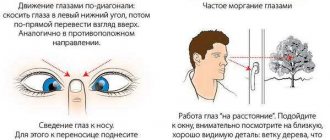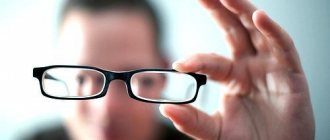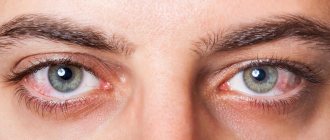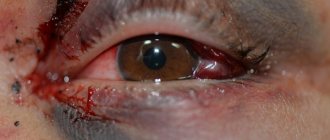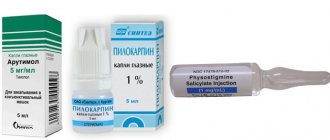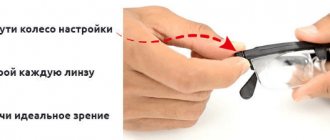What you need to know about self-diagnosis
You must understand that an at-home test will not replace a full-fledged vision diagnosis by an ophthalmologist. It is rather an auxiliary tool that allows you to detect changes in your vision in time and understand that it is time to seek help from a specialist.
Only timely detection of violations and their prompt correction can minimize harm to health and protect the body from possible negative consequences. It is recommended to visit an ophthalmologist at least once a year
, even if nothing bothers you. But this is primarily your area of responsibility - to monitor the condition of your vision and promptly respond to noticed changes.
Therefore, the methods we propose are not a replacement for an in-person visit to a specialist, but can be used as an additional tool for self-diagnosis!
What will an at-home vision test show?
Let us note right away: it is impossible to determine the exact visual acuity on your own, but you can identify a very approximate indicator.
The same applies to the diagnosis of various disorders - myopia, farsightedness and other vision pathologies. Only a doctor can determine this, and the diagnosis will be made after a comprehensive examination of the visual organs.
But you may suspect these disorders based on the results of a home test and contact a specialist to confirm or refute the diagnosis.
Sign up for a free vision test
Stages of a complete diagnostic examination of the visual system
- Determination of visual acuity;
- Detection of refractive errors (the ability of the optical system of the organ of vision to refract light rays);
- Measuring intraocular pressure;
- Ultrasound examination of the internal structures of the eye (including opaque media);
- Identification of internal pathologies;
- Inspection of the shape and refractive power of the cornea;
- Visual field examination;
- Inspection of the condition of the retina and optic nerve.
Carrying out a thorough diagnostic examination is impossible without the appropriate technical equipment of the clinic.
The latest computerized diagnostic devices, which the Moscow Eye Clinic has, are able to take into account the slightest discrepancies with the norm and determine the presence of pathology at the earliest stages of its development. This guarantees the accuracy of diagnosis with a complete picture of the patient’s visual system and the ability to predict the occurrence of diseases.
The diagnostic devices available in the MGK arsenal enable specialists to identify:
- refractive errors of the organ of vision (myopia, farsightedness, astigmatism);
- pathologies of refractive media (opacity of the cornea or lens);
- diseases of the receptor apparatus accompanying glaucoma, diabetes, retinal dystrophy.
Most vision testing procedures are carried out using a non-contact method, which avoids inflammation and reduces examination time.
Highly qualified specialists of the Moscow Eye Clinic, using the latest high-precision equipment, do not just determine the number of diopters of already existing myopia and hyperopia, or determine the presence of the disease! Our doctors detect problems of the visual system at a very early stage and begin treatment when the pathology has not yet had a significant impact on the functionality of the visual organ.
Checking visual acuity using the Sivtsev table
The well-known table with letters was developed by the Soviet ophthalmologist Dmitry Sivtsev; it is perfect for home testing.
The table contains 12 rows with letters of different heights. The top line is the largest; the lower the line, the smaller the size of the letters. Accordingly, the more lines a person clearly sees, the sharper his vision.
Next to each line, two values are indicated - D and V. The first, D, indicates the distance from which a person with good eyesight can clearly see all the letters of the selected line. The V value characterizes visual acuity.
To check, you will need a printed table. A4 format is sufficient, but it is important to first change the page settings to landscape orientation. The table must be hung on the wall, focusing on the 10th line - it should be at eye level. It is better to dim the light in the room, and additionally illuminate the table. Move about 5 meters away and begin the vision test.
If you do not have the opportunity to print, you can check your visual acuity online: display the vision test table on the monitor and move away 5 meters. If possible, move your computer higher so that the table is at eye level.
If you have not previously had vision problems, start checking immediately from line 10 - this is what people with 100% vision see. Can't distinguish some or all letters? Smoothly move across the table above until you reach the line where you can clearly distinguish all the letters. Each eye must be checked separately; it is better to cover the second eye with your palm while checking, but make sure that the closed eye is not closed.
With 100% vision there will be the following indicators: no more than one error in the rows V=0.3-0.6 and no more than two errors in the rows V>0.7. If you make more mistakes in any of the rows, your visual acuity is reduced. In this case, you should contact an ophthalmologist as soon as possible for a full diagnosis.
Sign up for a free vision test
Lines 11 and 12 are not indicative. If you can clearly see all the letters of these lines, it means that your visual acuity is excessively high, but this can only be said if you examine the letters without straining, squinting, or putting unnecessary strain on your eyes. This condition is not a pathology, but rather speaks about the characteristics of your vision or eye structure.
How to prepare for the test?
Before the test, give your eyes a good rest - spend at least half an hour without a computer, tablet, phone or book. It is better to do simple household chores that do not require significant visual stress.
If you wear glasses or contacts, it is recommended to remove your correction devices at least 10 minutes before the test.
How often to repeat a home visual acuity test?
If you do not feel any changes in your visual acuity in normal life, check it once every one to two months.
Features of testing in children
If you want to check your child’s vision, you can find on the Internet a special analogue of Sivtsev’s table, where pictures are shown instead of letters. However, in the case of children, we strongly advise visiting an ophthalmologist and not relying on the results of a home vision test.
Computer vision testing: 3 rules for successful diagnosis
Checking vision on a computer is a convenient and simple way of self-diagnosis, which does not require special equipment or special conditions for its implementation.
Online methods for assessing the quality of vision are based on the same tables from the ophthalmologist’s office, but in proportionally reduced sizes.
There are general rules for how a vision test should be carried out using a computer.
- Diagnostics should be carried out in a room with good lighting: bright enough, but not causing discomfort to the eyes.
- The visual organs should rest for some time before the test. Immediately before an online vision test, you should not read, view social networks, sew, or perform other activities that put strain on your eyes.
- Testing should be carried out when you are feeling well, with normal body temperature and blood pressure. You should not take a visual acuity test online while intoxicated.
Also, some sites can provide individual recommendations (for example, on a person’s distance from the computer) for a more accurate diagnosis of visual impairments.
All visual tests that are conducted online can be divided into several main categories:
- to assess visual acuity;
- to determine color blindness;
- to assess contrast sensitivity;
- for the diagnosis of astigmatic disorders;
- to determine refraction.
Checking for visual impairment using the duochrome test
The duochrome test allows you to suspect the presence of nearsightedness (myopia) or farsightedness (hyperopia) using a two-color picture. This check can be carried out online, on a computer or phone. If you wear glasses or contacts, remain wearing them during the test - the test can also show whether your correction device is correctly selected.
Sign up for a free vision test
The distance to the monitor during a vision test should be 50-70 cm. Determine the desired distance and look at the picture: if the letters on a green background seem clearer to you, this may indicate the presence of farsightedness. And vice versa - clearer letters on a red background may indicate the presence of myopia.
Let us clarify once again: a home vision test in front of a computer will not replace a full examination by an ophthalmologist, so even if you have passed the test and suspect any disorder, the final word will be with a specialist.
How to prepare for the test?
Give your eyes a little rest - relax, close your eyelids and sit like that for at least 5-7 minutes. If you are using correction equipment, please remain wearing it during the test.
The test only makes sense if you are in good health. Any ailment - headache, fever or illness - can affect the results.
How often should I test myopia/farsightedness at home?
This verification method does not require frequent repetitions. It is enough to take the test a couple of times a year. You can also take the test if you change your correction device, but only after your vision has adapted to the new glasses or contact lenses.
Online vision test
You can also take a general vision test online. To do this, you need to find a suitable site and run the test. You need to perform it at a distance of about 50-70 cm from the screen, and the monitor should be at eye level. Let's look at one example of such an online test.
Step 1. In this picture, you should evaluate the direction of the open side of the letter E.
Estimate the direction of the open side of the letter E
Step 2: Next, you need to press the arrow key corresponding to the selection.
Click on the corresponding arrow
Step 3. Gradually the size of the letter will change. You should continue to take the test, also choosing a specific arrow opposite the answer.
Continue taking the test
Step 4. After testing is completed, the results will appear. It is important to remember that the test is for informational purposes only. If the results are unsatisfactory, you should contact a specialist.
results
Home eye test for astigmatism
The simplest and most understandable test for astigmatism at home is the Siemens star. Expand the image to full screen, step back 3-5 steps and start checking. Each eye should be tested separately, as in the case of testing visual acuity, cover one eye with your palm, but do not squint.
Normally, a person sees a circle with both eyes. However, if you have astigmatism, during the test you may notice that the picture has changed to an ellipsoidal shape. With this visual disturbance, the rays seem to blur and overlap each other without reaching the center.
Sometimes a person notices an inversion: the background becomes black, and the rays become white. This effect may also indicate the presence of astigmatism.
However, the results of the test can be influenced by various factors, including lighting and the degree of eye moisture! Therefore, you cannot rely on an online test alone; it is necessary to confirm the diagnosis at an appointment with an ophthalmologist.
Sign up for a free vision test
How to prepare for the test?
You should check your vision for astigmatism in the morning. Correction devices must be removed at least 10 minutes before the test. The room should be sufficiently lit, and the brightness of the monitor should be dimmed to medium values.
How often should I repeat the check?
Incorrect perception of the Siemens star may indicate not only astigmatism, but also other visual impairments. You should repeat the check every few months, but make sure that the conditions - lighting, distance to the monitor, well-being - do not change.
Prices for vision testing services
The cost of diagnostic procedures is usually determined by the doctor, based on the patient’s complaints or the expected diagnosis. The price of an initial appointment with an ophthalmologist, including standard examinations (visual acuity testing, biomicroscopy, autorefractometry, small-pupil ophthalmoscopy, pneumotonometry) is 3,500 rubles, if additional examinations are required (before surgery for cataracts, glaucoma, laser vision correction, etc.) , then the total amount may increase.
High-quality, and most importantly, timely diagnosis will enable you to preserve the most valuable thing - your health!
What to do if, after a home test, you suspect vision problems
Visit an ophthalmologist as soon as possible and check your visual acuity and other parameters using professional equipment. As we have already said, it is simply impossible to test your vision normally at home. To make a diagnosis or rule out possible problems, the doctor evaluates not only your visual acuity, but also the general condition of your eyes.
To exclude the presence of vision problems or to respond in time to their occurrence, undergo a preventive examination by an ophthalmologist at least once a year.
Verification methods
Sitsev and Orlova tables
The simplest and most well-known verification method is the standard Sitzev tables. They have two options: with letters and with c-shaped circles turned at different angles.
The second option is used to test vision in children under 7-8 years old who have not yet learned to read.
The most important thing to consider when using tables is the correct ratio of their distance to the eyes and the size of the symbols printed on them. This ratio is determined using online programs.
It is enough to specify the checking distance and the required table length, after which the program will display a table with character sizes exactly suitable for the specified parameters.
The table can be printed, or you can check it directly on the monitor. In the second case, glare should not be allowed to appear. The table is printed on white A4 sheets.
If the checking distance is large and the A4 format is not enough to fit all the letters, then several sheets are printed and secured together with tape.
If a child is not interested in looking at images of abstract figures, then you can use a table (Orlova’s table), which shows various drawings.
The room should be well lit; to avoid intersecting light sources during the daytime, the curtains should be closed. The check is carried out from the tenth line of the table.
One eye needs to be closed, but not squinted; it is better to cover it with your hand. With healthy vision, the letters in the tenth line are clearly visible.
If you cannot see them, move to higher lines until you get a clear image of the characters on them. Repeat the procedure with the second eye.
Healthy people see line 10 (1.0) well; with minor impairments, only lines 8 and 9 (0.8 and 0.9, respectively) are visible; poor discrimination of higher lines clearly indicates vision problems.
The numbers (1.0, 0.9, 0.8, and so on) shown to the right of the lines indicate the percentage of visual acuity in relation to the norm.
You should not try to make a clear diagnosis for yourself.
This can only be done by an ophthalmologist during a comprehensive examination using procedures that cannot be done at home (for example, fundus examination).
Independent interpretation of the results can only indicate a possible problem and the direction of further diagnosis.
Duochrome test
If the test using the Sitsev table gives negative results, then you should undergo a duochrome test. Here it is also necessary to consider the symbols on the table, the difference is that it is divided into halves of red and green colors.
If the symbols are better visible on the green half, then farsightedness is evident, and good recognition of the image on the red half indicates myopia.
In this test, the table must be printed, since the color rendering of the monitor can make serious adjustments to the result. For children there is a version with c-shaped circles instead of letters.
Testing for astigmatism is carried out using sun-shaped images: several lines are drawn from the center at equal intervals along the entire circumference.
The thickness of the lines changes in such a way that a healthy person can easily distinguish them, but eyes affected by astigmatism would see these lines unclearly.
Color perception is tested using pictures consisting of many small circles of different colors, among which there is a line of the same color that forms a number. If the numbers differ without problems, then there are no problems with color perception.
Amsler table
More rare visual impairments can also be tested at home. Macular degeneration (central vision defect) is diagnosed using the Amsler table.
It looks simple: a lattice of black lines, forming squares of equal areas, and in the center is a black filled circle. To check, close one eye, and the other looks at the black dot for a minute.
With macular degeneration, the lattice will begin to deform, wavy lines, refractions and other distortions will appear on it.
Retinal camera TRC-50EX IMAGEnet 2000
Fluorescein angiography is used for a comprehensive analysis of various pathological changes in the retina. It is carried out both for diagnostic purposes and to determine the indications, tactics and timing of laser treatment and to evaluate its results. In our center, the TRC-50EX IMAGEnet 2000 retinal camera is used for this purpose - the best system that has no analogues in its wide functionality. It is very important to know that, thanks to the advantages of modern methods, all diagnostics at the Vision Restoration Center are carried out contactlessly, painlessly, quickly, and at the same time as accurately as possible. The non-contact diagnostic method eliminates the risk of infection or mechanical damage to the eyes.
As a result of many years and rich experience, our Center has developed an algorithm for diagnosing patients of various age groups - after all, pathological conditions of the eye also have an age-related coloration. Our diagnostics is based on the principle of an individual approach to the patient; we take into account the characteristics of each organism.
You can find a complete list of diagnostic equipment on the page: ophthalmological equipment of the Center.
How to test your vision using the Orlova table
Orlova's table is intended for testing the vision of children and preschoolers who are not familiar with letters and do not know numbers. When testing visual perception, a picture with objects familiar to children is used.
The experts who check lead the child to the content, show the depicted objects - to find out what words the child reproduces when he sees the test objects. The determination of vigilance degeneration is carried out similarly to Sivtsev’s table.
The check is carried out carefully, showing a symbol in each of the contained rows to avoid overtiring the baby. If an item in a row is named incorrectly, you need to name in detail the remaining items located with the incorrectly named one.
It is literally easy to determine the blockage in visual acuity using the table. You need to start checking the deformation from the top line, where the largest animals and understandable symbols are located, gradually moving down the list.
This test or catalog will certainly demonstrate a mushroom, a star, a horse, an airplane, an elephant, a teapot, a duck and other popular objects.
